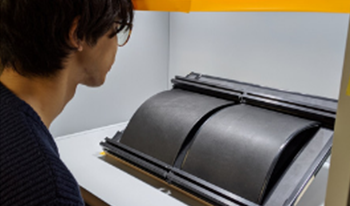References
1
2ChenX.BarnesC. J.ChildsT. H. C.HensonB.ShaoF.2009Materials ‘tactile testing and characterization for consumer products’ affective packaging designMaterials Design.30429943104299–31010.1016/j.matdes.2009.04.021
3DooleyR. P.ShawR.1979Noise perception in electrophotographyJ. Appl. Photographic Engineering5190196190–6
4FlemingR. W.NishidaS.GegenfurtnerK. R.2015Perception of material properties (part I)Vision Res.109(B)123236123–23610.1016/j.visres.2015.01.014
5FlemingR. W.NishidaS.GegenfurtnerK. R.2015Perception of material properties (part II)Vision Res.115(B)157302157–30210.1016/j.visres.2015.08.006
6GodaN.TachibanaA.OkazawaG.KomatsuH.2014Representation of the material properties of objects in the visual cortex of nonhuman primatesJ. Neurosci.34266026732660–7310.1523/JNEUROSCI.2593-13.2014
7HashimI. H. M.KumamotoS.TakemuraK.MaenoT.OkudaS.MoriY.2017Tactile evaluation feedback system for multi-layered structure inspired by human tactile perception mechanismMDPI Sensors.17260110.3390/s17112601
8HiramatsuC.GodaN.KomatsuH.2011Transformation from image-based to perceptual representation of materials along the human ventral visual pathwayNeuroImage57482494482–9410.1016/j.neuroimage.2011.04.056
9HiroseY.InagakiT.TanakaT.OgatsuH.1988Image noise evaluation method for xerographic prints of digitized imageJapan Hardcopy’88189192189–92
10HirschfeldH. O.1935A connection between correlation and contingencyMath. Proc. Camb. Phil. Soc.31520524520–410.1017/S0305004100013517
11KirchnerE.Van der LansI.PeralesE.Martínez-VerdúF.CamposJ.FerreroA.2015Visibility of sparkle in metallic paintsJ. Opt. Soc. Am. A32921927921–710.1364/JOSAA.32.000921
12
13NaganoH.OkamotoS.YamadaY.Semantically layered structure of tactile textures9th Int’l. Conf., EuroHaptics 2014 Proceedings I2014SpringerBerlin, Heidelberg, Germany393–9
14SchefféH.The Analysis of Variance1959John Wiley & Sons, Inc.New York, United States
15ShimodeY.OhtaniY.YasunagaH.2011How do craftspeople distinguish the appearance of natural-lacquerware? -Approach by optical image analysisJ. Japan Soc. Colour Material.84818681–610.4011/shikizai.84.81
16TaniY.NagaiT.KoidaK.KitazakiM.NakauchiS.2014Experts and novices use the same factors–but differently–to evaluate pearl qualityPLOS ONE97
17TobitaniK.NakajimaK.KatahiraK.NishijimaK.NagataN.
18UchidaO.2007Consideration and proposal concerning the analysis for paired comparison and matching test by correspondence analysisJ. Tokyo University of Information Sciences111101–10
19WatanabeS.2019One-shot multi-angle measurement device for evaluating the sparkle impressionJ. Imaging Sci. Technol.6306040110.2352/J.ImagingSci.Technol.2019.63.6.060401
20WatanabeS.SoneT.Evaluation of sparkle impression considering observation distanceIS&T Electronic Imaging: Material Appearance Proceedings2019IS&TSpringfield, VA151–5
21YanaiH.Inshi bunseki1990Asakura PublisherTokyo, Japan

 Find this author on Google Scholar
Find this author on Google Scholar Find this author on PubMed
Find this author on PubMed